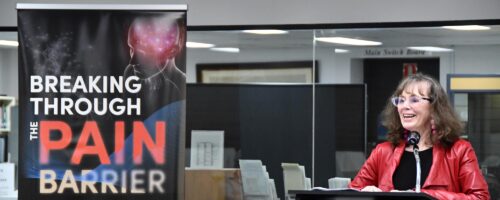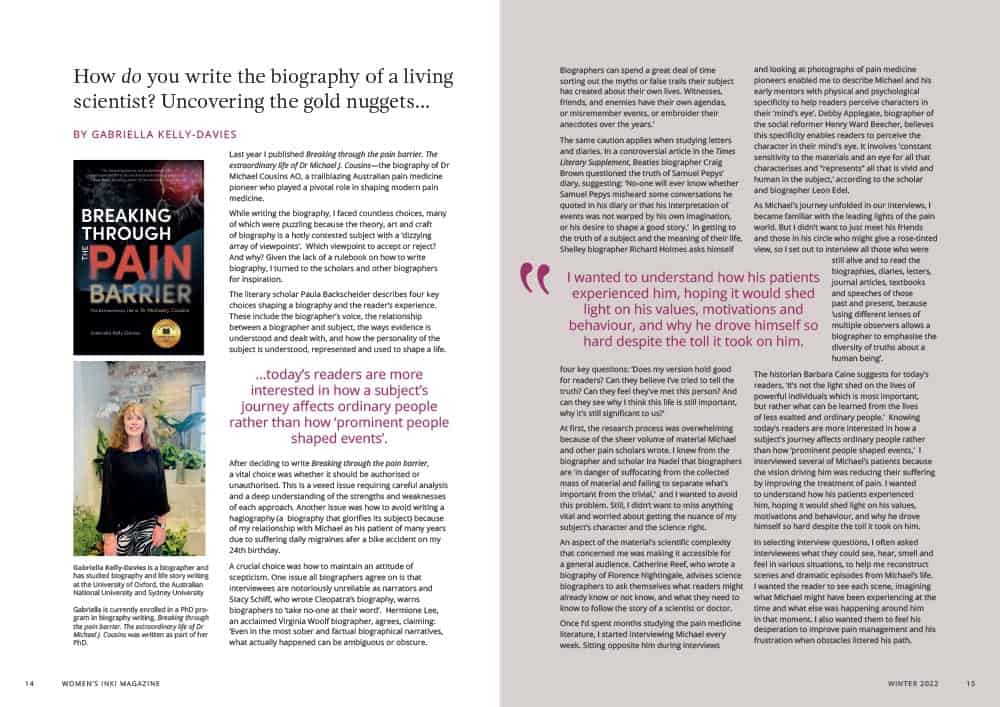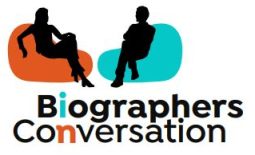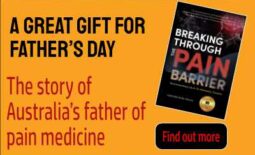Literary magazine features my biography tips
“Women’s Ink” Magazine profiled my tips on some of the choices involved in writing the biography of a living scientist. These tips fall into four key categories:
Choice # 1
The first was deciding how to write Michael’s biography so that it captured his passion for science, pain medicine, his patients, and his family. I also needed to portray the essence of scientific wonder and its centrality in his life.
To some biographers, unlocking the Eureka moment is so important they focus on it exclusively rather than writing a three-dimensional portrait of a whole person. But I wanted to strike a balancebetween portraying Michael’s public and private lives, the second category of choice.
Choice # 2
Patrick White’s biographer, David Marr, believes the ‘potency of biography is its compelling intimacy’. To achieve this intimacy, the Oxford scholar and Virginia Woolf biographer, Hermione Lee, urges biographers ‘to get behind the public performance and show us the real person at home in his undress’. But is this possible? Virginia Woolf claimed: ‘biographers pretend they know people,’ and several scholars argue that biographies create an illusion of intimacy, rather than real intimacy.
So to what extent can biographers truly get to know their subject and how should they balance all aspects of a person’s life? This question lies at the heart of contemporary biography and would fill a library, so time doesn’t permit us to explore it, but it does take us to the third category of choice.
Choice # 3
The third category of choice involves the many challenges faced by biographers of the living, particularly issues around privacy and security, ethical choices about disclosure, and potential legal disputes, to name a few. Some scholars argue that biographies of the living are not ‘true biographies’ because history, by definition, is concerned with the past and so the concept of writing about a living subject who is ‘not yet a part of history,’ is contradictory. These ‘purists’ insist it’s not possible to attain proper scholarly distance or rigorous historical analysis with a living scientist.
However, when a living subject trusts a biographer and opens up to them about their innermost thoughts and feelings, their biography has the potential to reflect a much deeper, nuanced philosophical and psychological portrait than would otherwise be possible.
Living subjects also open doors for biographers and provide vital historical documents that might not be stored in an archive. Interviewing a living subject enables a biographer to observe their gestures, mode of speaking, body language and mannerisms, providing a glimpse into the subtle things that ‘make up an individual’.
Choice #4
This takes us to narrative strategy, the fourth category of choice, because it’s key to how a biographer translates observations into captivating narrative. Choosing a narrative strategy involves decisions about structure, narrative voice, pace, rhythm, word choice, interpretation and the use of fiction techniques.
The power of storytelling depends on how a biographer chooses to capture a subject’s distinctive characteristics and sculpt a perfect likeness, bringing a subject to life and keeping the reader sitting on the edge of their seat wondering what happens next.
While choosing the ‘right’ narrative strategy can involve years of trial and error, I learned that it’s fine to try one approach, assess it, then discard or rewrite it, no matter how many drafts it takes.
I took comfort from Virginia Woolf’s admission that one of her letters to The Times went through 27 drafts! So did Kate Grenville’s biography of her mother, Nance Russell.








